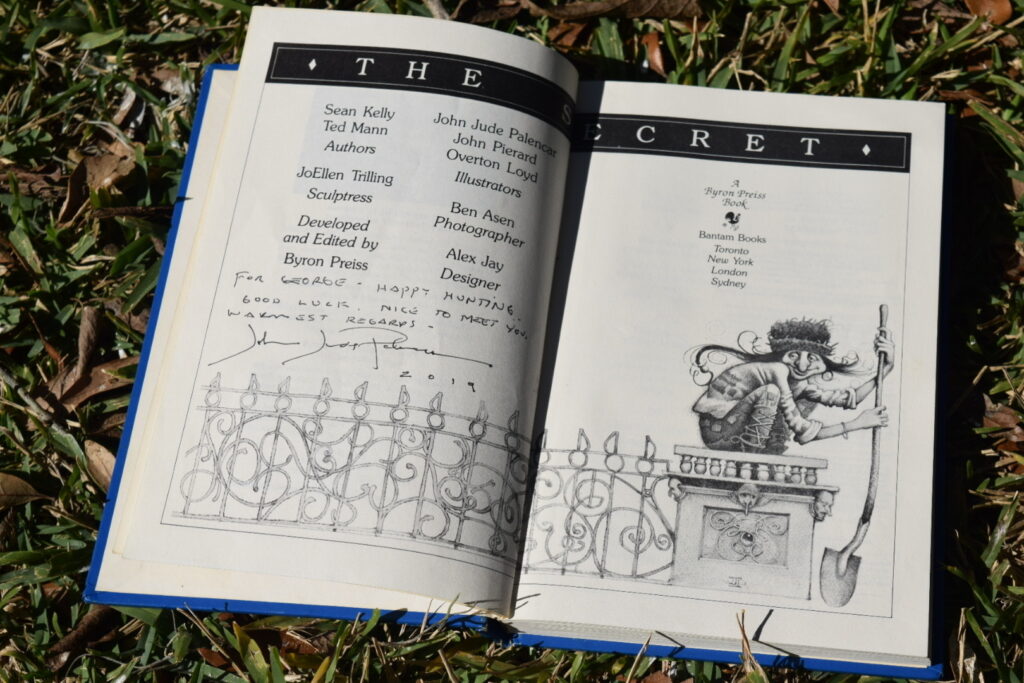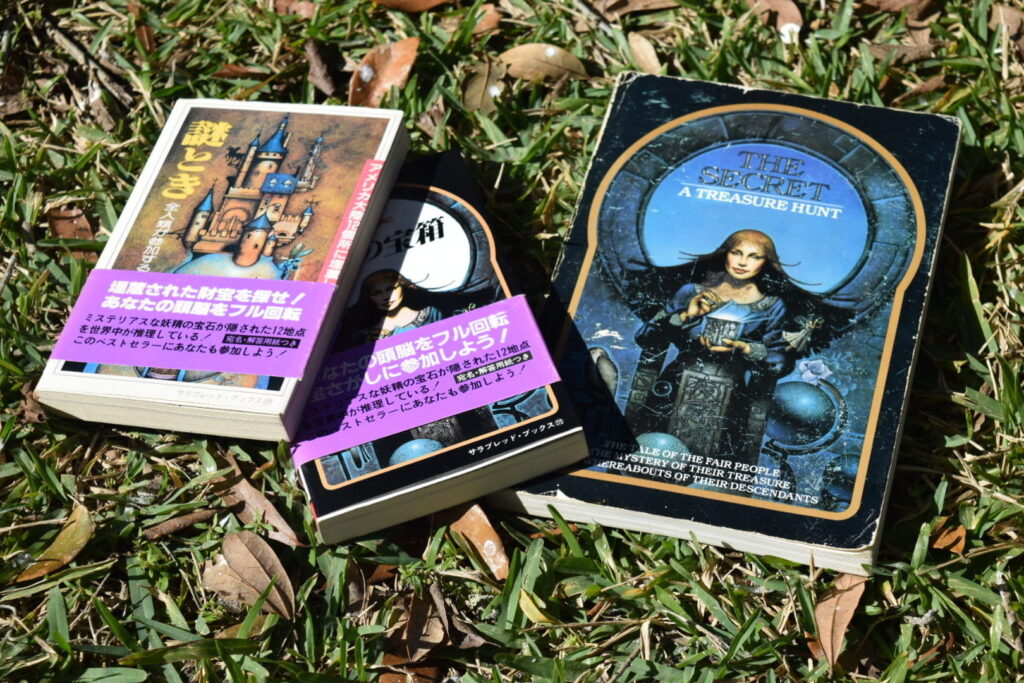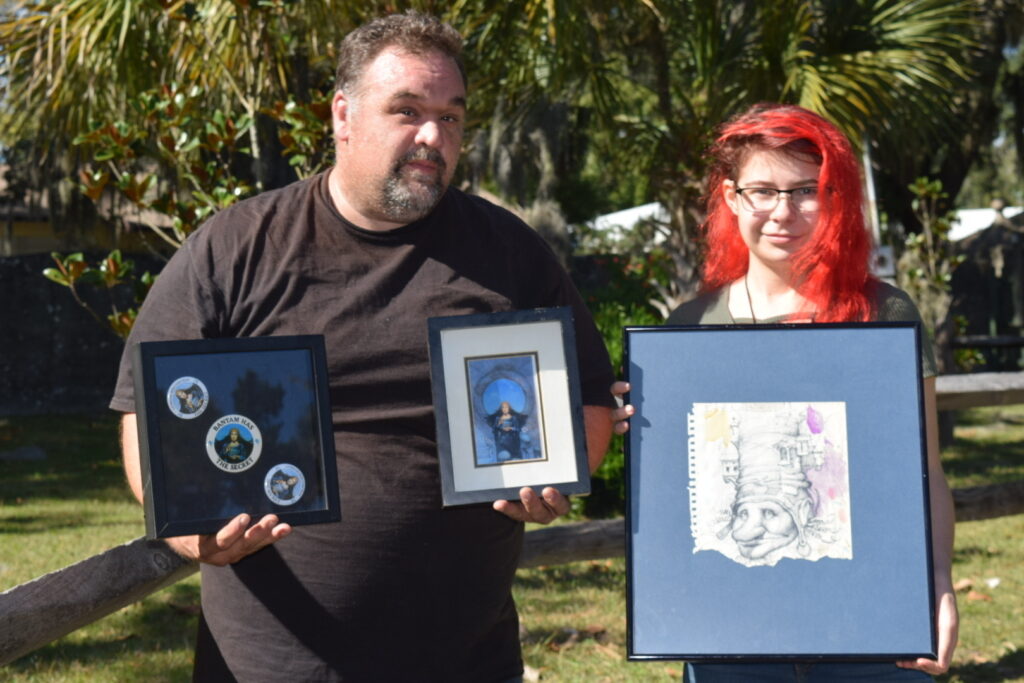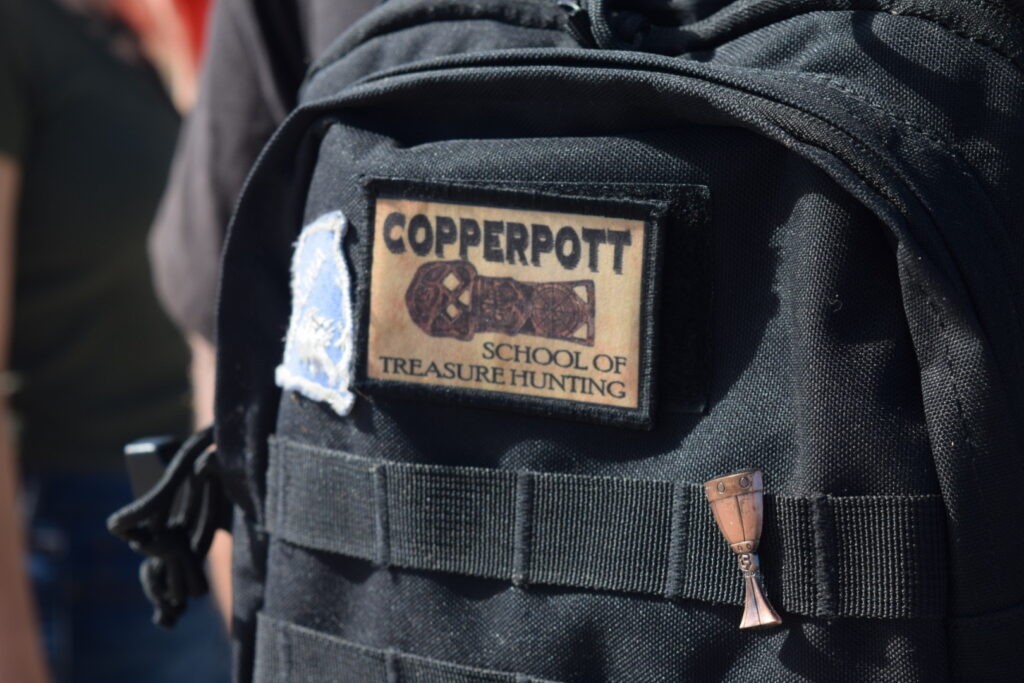Treasure hunters must scour 9.54-million square miles to find the perfect 5-by-7-inch hole to dig

John Jude Palencar, “The Secret” artist, signed Ward’s hardcover version of the book. “Happy Hunting,” he wished him nearly two years ago. Now, the two have kindled a real friendship based on their shared wonder in a fantasy world.
Feb. 17, 2022 | Story and photos by Avery Lotz
Cyndi Hendry obsesses over the hunt.
Intrusive thoughts take hold of her consciousness late at night and rip her from her sleep. She ponders religious connections, retraces streets in her mind and pictures the roughly 20,000 screenshots she stores in her phone. She snatches a paperback book from her bedside table to find a rainbow of pink, yellow, white and orange sticky notes and bookmarks that fill the heavily scoured pages.
She wakes up exhausted for work the next morning. The Fort Myers clerk spends her days working “in the crime business,” yet she’s lost herself in another investigation. On her return home, she closes herself in her sanctuary, where hours slip by like minutes.
In her pastel pink office, she and her daughter’s six shared cats spring between pieces of furniture and pad across her desk. But she’s unbothered by the meows — she has a mystery to solve. And it’s just within her grasp.
She has not visited Montreal, Milwaukee or New York City on her search, but the streets and parks of each are etched into her mind. Google Maps has acted as her tour guide.
Closer to her home lies St. Augustine. Hendry thinks a park nestled within the four-century-old city may lead her to treasure buried over 40 years ago.
In 1981, Byron Preiss buried 12 ceramic containers, called casques, across parks in North America. Each casque protected a carved key. A year after Preiss planted his boxes, he published a treasure map in the form of a roughly 220-page book, “The Secret: A Treasure Hunt,” which contains 12 poems and 12 paintings as clues to find the casques. Preiss did not disclose which verse matched which image.
Preiss’ treasure hunt was crafted with a team of two writers, three illustrators, a photographer and a sculptor. But “The Secret” is more than a hunt; it’s an invitation to a fantasy world.
Across the 9.54-million square miles of North America, treasure hunters — some call themselves “secreteers” while others dub themselves “keysearchers” — must find the perfect 5-by-7-inch hole to dig. The finder of an underground urn can redeem the key inside for a precious gem when returned to Preiss’ wife and children. Together the 12 gems value about $10,000.
But it’s not the money that lures the thousands of treasure hunters. They are enticed by community, connection and childhood whimsy. What some searchers have nicknamed “Goonies for grown-ups” embodies the resolve to never give up. Despite the more than 10,000 people in the Facebook group, “The Secret: A Treasure Hunt,” so far only three casques have been found in Cleveland, Boston and Chicago.
Two of those were uncovered before Preiss died in a car accident in 2005.
Ben Asen, Preiss’ long-time friend and photographer for “The Secret,” said the book was not an initial success. Through the 1980s and 1990s, Asen heard little of the project. He eventually stopped thinking about the six-month journey he took at Preiss‘ request to photograph artist Jo-Ellen Trilling’s sculptures of magical creatures across America.
He snapped photos of around 40 gnomes, sprites, hobbits and more to include in the book. He wondered whether they would ever be received by a large audience.

Ward has both Japanese and English translations of the book. When “The Secret” did not inspire initial interest in North America, the rights were sold, allowing for publication overseas.
“Any idea he came to me with that was a little nutty, it did not surprise me at all,” Asen says.
Social media and Discovery Channel specials skyrocketed the book’s success decades after its publication. Celebrity archaeologist Josh Gates, the host of Discovery Channel’s “Expedition Unknown,” accompanied treasure hunter Jason Krupat on his 2019 dig for the Boston casque. Hendry watched on television as Krupat pulled the broken key from a pile of dirt in a construction zone. That moment served as both an invitation to the hunt and a warning that, without haste, the casques may be lost or destroyed forever.
Preiss‘ wife, his daughters, friends like Asen and an international society of secreteers have kept his legacy — and his mystery — alive. Daily conversations on Facebook and well-documented searches keep these treasure hunters abreast of the latest developments in the mystery. And the mystery has yet to be unraveled.
Hendry gets emotional when she discusses that legacy — one of a man she never met yet whose mind she has picked apart with the meticulous drive of a detective.
The hunt is not about the prize, not to Hendry. She says she hunts out of respect. She hunts to further the memory of the first secreteer and the puzzles he left hidden in plain sight.
Seekers of Preiss’ treasures have developed theories as to where in North America the other casques hide: San Francisco, Roanoke Island, New Orleans, Montreal, Charleston, Houston, Milwaukee, New York City — and, to Hendry’s delight, St. Augustine.
‘The first chapter, written in water’: St. Augustine’s treasure
The ninth poem and sixth illustration of Preiss’ book are said to lead to St. Augustine, settled by the Spaniards and thought to be the oldest town in America. Though his book does not instruct how readers should pair the illustrations with poems, all known theories point to the town. “The Secret” artist John Jude Palencar confirmed the casque was buried there in an interview on The Secret Podcast earlier this year.
Hendry suspects that Preiss buried the casques on the property of one of two historical sites: the Old Spanish Chimney and Well or the Castillo de San Marcos.
A trip through Anastasia Island may be necessary to draw the connections. Street names, like Asturias Street and Santander Street, are possible clues. One of the first cartographers to map the area had the last name “Silver” — a word mentioned in the ninth verse alongside limestone, shell and salt. Many treasure hunters like Hendry have also made a connection to coquina rock, a common sedimentary rock found in St. Augustine. The walls of the Castillo are made from this stone — specifically, stone pulled from the chimney and well centuries ago.
But Hendry still holds her skepticism. She has theories in other areas of the state, from Tampa to Everglades National Park.
George Ward, a St. Augustine resident, first stumbled upon the treasure hunt when crafting his own puzzles with his friends a decade ago. He thought Preiss’ hunt looked childish. But its simplicity and eccentricity enchanted him.

Ward and his stepdaughter Destiny hold original artwork and promotional material for the book. Over the years, Ward has amassed a large collection of “The Secret” trinkets, allowing him to hold pieces of history while the story’s legacy still unfolds.
“A lot of people now just don’t have any excitement and wonder in their life,” he says. “A lot of people are missing that playfulness, that excitement that you had as a child where you were learning new things, you’re experiencing new things and everything was amazing. I think ‘The Secret’ brings that to people.”
He told his fiancée he could solve the St. Augustine challenge in two weeks, and he would set her wedding ring with the gem he would receive as a reward for unearthing the casque.
Over a decade later, he is still engaged to be married. And when asked about the casque’s location, he says with confidence: “I have no idea.”
He has yet to find a casque, but he has “put a hole in the ground” in all but two cities where the treasures are suspected to be buried. He’s uncovered a community that transcends the borders of St. Augustine.
In Thanksgiving of 2021, fellow seekers of Preiss’ casques joined Ward’s family for turkey and talk of treasure. Ward’s stepdaughter, Destiny Ritenour, joked that having strangers in the house was a common occurrence. But to Ward, they’re not strangers. They’re secreteers — and that’s enough for him to call them his friends.
“There’s no monetary goal, so there’s no point in being secretive, and there’s no point in working alone,” Ward says. “It’s much easier to work as a community.”
But finding the casques could be bittersweet.
“That means that part is over,” he says. “When the Boston casque was found, the solution answered a few questions, but it also made the community sad because there’s one less now.”
At first, Ward believed the poem aligned with the path of the Fountain of Youth Archaeological Park, said to be where Ponce de Leon landed on North American shores, which began attracting visitors in the 1860s. He strolls through the park almost weekly like it’s his own neighborhood. Even the park’s peacocks seem to recognize him. But he has dug throughout the grounds — with permission from owner John Fraser — to no avail. The spot he is confident could have held the casque now borders a seawall. In the 1980s, when Preiss began his North American journey, the grassy area led to an untouched shoreline.

The Fountain of Youth, where Ward stops for the occasional quick sip of water, which provides him relief from the hot afternoon sun. “I’m actually 800 years old,” he joked to a stranger nearby. He knew the park so well, one may have wondered if he’d visited to reap the fountain’s rumoured anti-aging benefits.
“You’ve got to keep hope,” he says. “We all assumed Boston was lost until it was found.”
Still, history buff and Keystone Heights resident Brennan Clance thinks the path to discovery is dispersed throughout the city. Just as Preiss explored the towns where he scattered his oddities, Clance said the publisher would’ve wanted those searching for them to do the same.
“People need to learn about the city,” he says. “They need to learn about the Siege of 1740 and learn about the different things that happened in St. Augustine and get a chance to just soak in that history.”
The poem, he believes, starts at the Castillo de San Marcos, then leads treasure hunters on a 5,000-foot journey over the Bridge of Lions to Oglethorpe Battery Park where the casque could rest.
Though he just started searching a year ago, “The Secret” has already found a home in the back of Clance’s mind.
“During the pandemic, it’s given me a little bit of reason in my life to keep moving forward, to keep going and getting up every day,” he says.
Though it takes a certain curiosity and unparalleled patience to join the hunt, there is no age requirement.
‘Near men, with wind rose’: a team of women and children
Two years ago, Rachel Nacion-Ograyensek watched Josh Gates’ Boston special with her then-7-year-old son Patrick. A sapphire, the gem that the finder of the St. Augustine casque would earn based on a hidden stone in the painting, is Nacion-Ograyensek’s birthstone.
“I want to find it for you, Mama,” Patrick, now 9, announced. “I can do that.”
Patrick, Nacion-Ograyensek says, is afraid of ants but would leap to investigate Egyptian mummies’ tombs. His unquenchable thirst for adventure, like that of the adult secreteers, reminds his 46-year-old mother of “The Goonies.”
And like Goonies never say “die,” Patrick says he won’t ever give up on the hunt. The elementary school Indiana Jones still inspects the illustrations, turning them every which way in search of clues.
About a year ago, he reached his first conclusion: “It’s a waterfall.”
“Adults see it too literally; they don’t see it from a kid’s perspective,” Nacion-Ograyensek says. “And I think a kid’s perspective goes a long way.”
The mother and son have a method. Patrick, the imaginative adventurer, sees telling shapes in the images, and Nacion-Ograyensek serves as his armchair researcher. She delves into history and lore based on her son’s theories.
“Maybe it’s built to be a team process,” she says. “Maybe it’s meant to be a family process.”
As generations slip by, casques remain unfound. Asen once thought that meant the end. He wondered if the treasures had met their final resting place in a brown vastness, only to be seen by the passing earthworm. But today, he sees families who hunt together and children who carry on the legend — in their imaginations and in their backpacks.

Ward’s backpack is home to a plethora of pins and patches, but one stands out. “Copperpott School of Treasure Hunting” it read, an homage to the 1980s adventure of “The Goonies.”
‘Years pass, rain falls’: a continued legacy
Asen isn’t sure if his science-fiction-loving friend, Preiss, would have expected the level of enthusiasm his mystery has achieved. But he would have embraced it. In October, Asen attended a meetup in Manhattan and was shocked to hear some drove close to 20 hours to be there.
People often ask him, “Ben, do you know where the treasures are buried?” to which he responds, “Byron’s wife didn’t know where the treasures are buried. Only one person did, and that was Byron Preiss.”
Still, the secrets between the two didn’t hurt their bond.
The publisher and the struggling photographer became architects of an imaginary world and close friends until the end. The same mysteries have created similar bonds for countless other searchers, like Hendry. But, more than that, Hendry says researching history has taught her about American atrocities. As she studied migrations to the Americas for clues to the hunt, she learned more about the maltreatment of Native Americans than she had in school.
“That’s what makes Byron Preiss a good teacher,” she says. “He showed us what America was all about: the good, bad and the ugly of it.”
Hendry and her peers know Preiss’ treasures may forever live in the ground. Some may be buried in protected state parks where digging could be impossible without trespassing. Other casques — even of the few that have been unearthed — have fractured into dust after decades of development above them. Yet she keeps searching, and she hopes others will, too.
Only men have uncovered the three casques, she says. Yet she and Nacion-Ogryensek share the same calling. They want women to break the “all-male Secret Society ceiling.” A nation-wide squad of female treasure hunters, some who once called themselves “All the Secret Ladies,” find strength in their shared experience of treasure hunting in a male-dominated universe.
“You don’t know the investigative skills of a woman,” Hendry jokes.
Women have served as “feet on the ground” for Hendry across the country — whether they are fellow secreteers or strangers to the hunt who encounter Hendry’s contagious enthusiasm. In North Carolina, she extended the hunt to a florist and theme park manager whom she’s only met over phone and Zoom calls. But she mailed the Land of Oz caretaker a token of her gratitude for listening to her theory about the potential casque beneath Beech Mountain’s yellow brick road: a probe and a paperback book that binds an eternal mystery within its spine.
When the St. Augustine casque’s shell is opened once more, maybe that glass ceiling will shatter. But maybe it will never feel the St. Augustine sun — maybe it’s not even in St. Augustine.
Yet the treasure is not in the find. No, the treasure is in the community. And the hunt, which secreteers strive for even 40 years after its inception, goes on.
Avery Lotz is Atrium's co-Editor in Chief and Print Editor. She has written for CNN, WUFT News, The Independent Florida Alligator and Her Campus UFL. In her free time, she enjoys surfing, painting and exploring the Sunshine State.
